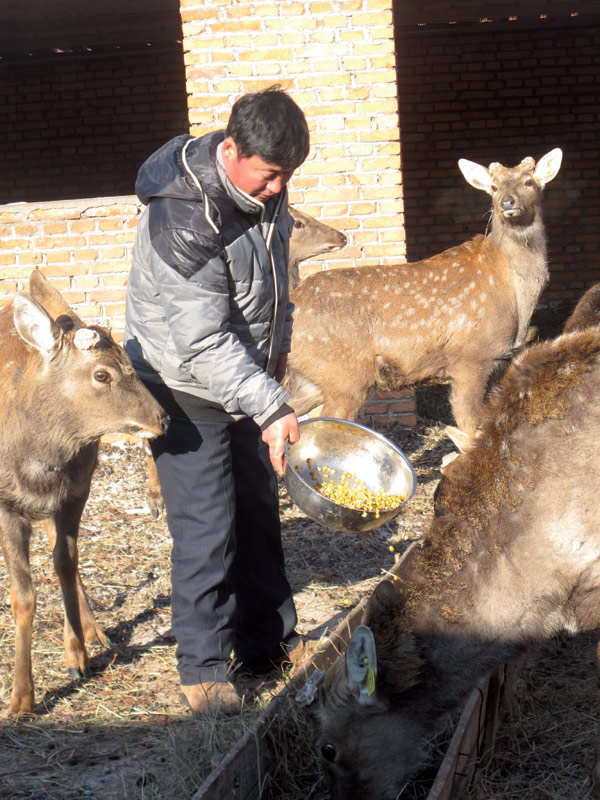Life after logging
Updated: 2013-02-25 05:56
By Wang Kaihao (China Daily)
|
|||||||||||
|
 Raising sika deer has become a new source of income for many former lumberjacks in Bailang town. Photos by Wang Kaihao / China Daily |
Former forestry workers are adapting to the times as central government directives emphasize conservation rather than chopping down trees. In Inner Mongolia autonomous region, Wang Kaihao reports on some creative employment solutions in Arxan.
For seven months a year heavy snow covers Arxan, by the Sino-Mongolian border, in the far northeast Inner Mongolia autonomous region and near the Greater Hinggan Mountains. It takes just a few minutes to drive through Arxan, which has just 8,000 residents, and locals jokingly call it China's smallest city.
Driving south into the deep forest along a zig-zag route for 30 km, visitors will come across Bailang town, which means "a fertile place" in Mongolian. Temperatures drop below -30 C in January.
Li Shuying, 49, is busy cutting and pasting tree bark in her Birch Forest Studio, which is a narrow cabin filled with decorative wooden pictures, some on the walls and others piled in the corner. The pictures portray natural scenes, historical figures and animals.
"Bark is my ink," she says. "I am proud to live in the forest with its wide variety of trees that provide so many colorful bark samples for my works."
Bailang developed after Bailang Forestry Center was established in 1946. The center was listed as one of 30 forestry centers under the national forestry bureau in 1962 and provided 30,000 cubic meters of timber a year to make it a major lumber hub in Northeast China.
However, after China was hit by severe flooding in 1998, the central government made the decision to launch a nationwide forest protection project to counteract the effects of natural disasters. Tree felling in Bailang was limited to 6,000 cubic meters annually.
"Forestry workers used to be called "Big Bosses of the Forest'," sighs Yu Jifang, the Party chief of Bailang town. "It was a very popular and profitable job, but there was a crisis around 2000.
"We had no concept of sustainable development for years and exploited forest resources, which we should have cherished more. If the situation had continued, Bailang would have become a wasteland."
Yu says the forests of Bailang are crucial to countering sandstorms from the Mongolian Plateau and protecting the nearby grasslands and headwaters of several of Northeast China's major rivers.
Preserving the forest, however, led to layoffs for workers like the artist Li Shuying. Though her forest ranger husband avoided unemployment, Li needed to come up with another form of income, which is when she became a bark artist, in 2004, after seeing similar works in other provinces.
"I am a layperson when it comes to the arts," she says modestly. "But I'm good at copying others' paintings."
She wishes she was stronger and could climb the mountains every day to collect bark from dead trees, but instead buys bark at a price of 3 yuan a kilogram, and earns about 30,000 yuan ($4,800) a year. She expects one of her recent works, a huge picture of peonies, will sell for thousands of yuan.
Even more rigid forestry conservation regulations were imposed in January 2012 to prevent logging in Bailang, and now only dead trees can be cleared to get lumber.
Li says she nevertheless has confidence in the future as she is expanding her business and will employ jobless women as apprentices.
She says her paintings were popular at a Hong Kong exhibition in 2011 and employing more people will enable her to meet bigger orders, which she couldn't do in the past.
Other former lumberjacks have found salvation in the booming tourism industry. In 2012, 1.1 million tourists poured into Arxan during the summer months to enjoy the wonderful natural scenery. Approximately 20,000 visitors went to Bailang, which the Party chief Yu says has huge potential, as the infrastructure is still developing.
"When the people drop their axes, they can pick up the flags of tour guides," Yu says.
The government spent an average of 23,000 yuan renovating homes for 70 families in 2012 so they are better prepared to provide accommodation for visitors.
Resident Li Yanbing was one of the lucky ones. She says most of the family's income comes from her husband's work in a timber processing plant.
"The factory still has some remaining timber, which was cut before the logging ban," she comments. "But once it is used up, what work will they have then?"
Transforming her newly decorated cabin into a small inn and store selling local specialties like mushrooms provides hope. She says she gets excited when visitors from the capital arrive.
"Life here is slow and the air is fresh. I believe Beijingers cannot resist the town's charm," she says, laughing.
Bailang is on average about 1,200 meters above sea level and has just 80 days in the year when it is frost-free, which makes it difficult to plant regular crops, except a small amount of barley and potatoes, according to Ren Jianfei, an official in charge of tourism at Bailang forestry bureau.
The bureau opened an experimental sika deer farm in 2002 and it turned out to be a huge success.
Liu Hongbo, 45, worked as a lumberjack for 22 years, until 2002, when he was being paid just 130 yuan a month and the job was unsustainable. He was one of the first 40 residents to receive a 35,000 yuan free-interest loan from the government in 2003 to raise sika deer.
He was also provided six deer and a cabin in the newly established Lucun (which means "deer village") to start his new business.
"I had worked in forestry all my life and never even considered that I could do something else."
Liu now has 26 deer and earns more than 30,000 yuan a year by harvesting antler velvet, a mainstay in traditional Chinese medicine, plus other related products.
He also has a supervisory job at the forestry bureau overseeing the principal deer farm, which earns him a salary of 3,000 yuan a month.
"Thank goodness, deer have made our outpost known beyond the mountains," he says. "We don't even have to go to the market as wholesalers from all over the country gather here during the antler velvet harvest."
According to Ren Jianfei, more than 70 lumberjacks and their families have moved into Lucun and become deer farmers, comprising 10 percent of the bureau's employees.
Bailang currently has 1,350 deer and the forestry workers have an average annual income of 10,879 yuan, which is four times more than a decade ago.
The bureau also plans to sign a five-year contract with former forestry workers to plant spruce trees on the mountain, which will help increase the forested area by 200 hectares every year.
National forestry bureau statistics suggest 484,000 surplus forestry workers in Northeast China took on jobs in other industries between 2000 and 2010.
"We're still exploring more ways to adapt to life after logging," Ren says. "We live in a land of green treasures and there's no reason to cut the trees down or move elsewhere."
Contact the writer at wangkaihao@chinadaily.com.cn.
|
Two lively foxes made from tree bark is typical of Li Shuying's newfound craft. Her family's income had depended on logging before. |
|
Plenty of families have opened inns in this small town nestled in the depths of Great Hinggan Mountains, to cater to the increasing number of tourists. |
(China Daily 02/25/2013 page20)
Today's Top News
Police continue manhunt for 2nd bombing suspect
H7N9 flu transmission studied
8% growth predicted for Q2
Nuke reactor gets foreign contract
First couple on Time's list of most influential
'Green' awareness levels drop in Beijing
Palace Museum spruces up
Trading channels 'need to broaden'
Hot Topics
Lunar probe , China growth forecasts, Emission rules get tougher, China seen through 'colored lens', International board,
Editor's Picks

|

|

|

|

|

|







